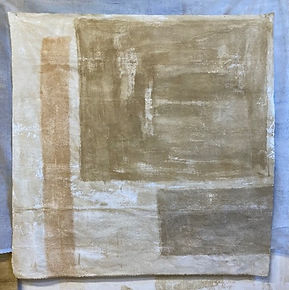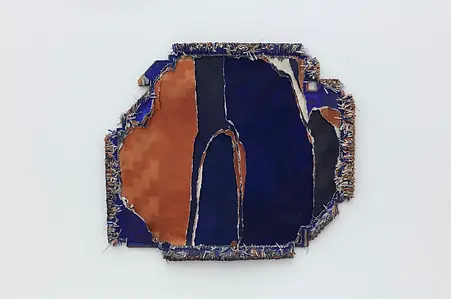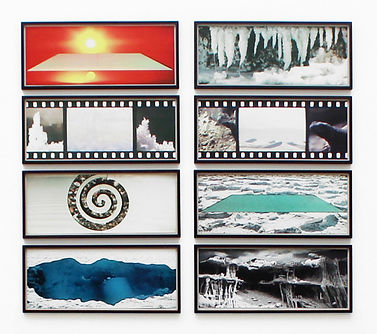critical reflection
My initial research question is to investigate ways in which we connect to and represent our experience of landscape at the coast. Through the MA I want to find ways to build on my past work, understand better my motivations and thematic contexts for making work and find a clearer visual language for my printmaking practice. Below is some of my previous work which I reviewed to help focus my research see more details here.
This connection I have with coastal landscapes comes from regular seaside holidays, having lived by the sea in Sussex for a short time and from walking the southwest coast path in recent years. A visit to the seaside has a clear link to ideas around English/British identity, but it is about the feeling of freedom, aliveness and finding of self that I have in these locations that drives my art. This was the starting point for my research during unit 1.


Fabric trace prints with Dorset pigment (2019); Lino etching on fabric with limestone pigment (2022), Burren, Ireland
interactions with nature
In 2017 I saw Jessica Warboys work at Tate St Ives which presented a series of ‘Sea Paintings’ she had made on the English coast. She made these by taking canvases with pigment into the sea to ‘co-create with the sea’. In her dialogue with nature Warboys’ Sea Paintings reveal and document a trace of an action – the interaction between herself, the sea and the artwork.
Warboys J. Sea Paintings, British Art Show, 2016 and production shot, © Finch, Mick and Warboys, Jessica
My interest in working directly with nature, in part by using materials from specific locations, developed from seeing these Sea Paintings alongside work by earth artists such as Richard Long – specifically his mud paintings and walking, and Ana Mendieta’s Silueta series. These artists encouraged me to work with scale, use elements such as seawater, earth pigments and film in specific locations.
Richard Long (Installation), River Avon Mud Line, 2020, From a rolling stone to now, Lisson Gallery, New York; Mendieta A. (1976) Untitled, from the Silueta Series
This clearly connects strongly to ideas around earth/land art and landscape and I had previously read writers such as Mitchell, Lippard and Boetzkes. Within my work I was less concerned with leaving a dominating mark or artwork out in the environment, for example, in the way that early land artists such as Robert Smithson did with Spiral Jetty in 1969-70, and more with finding a way to have an essence of the place in the work, to bring it back to the studio and continue the dialogue with nature.
At a crit it was suggested I look at Tanoa Sasraku’s Terratypes. These are a series of what Sasraku calls ‘earth photos’ that work with both local earth pigment and sea/river water in these hybrid print, textile, painting, sculptures and in doing so also brings place directly into the work. In an interview at Spike Island gallery, Sasraku discusses how these works explore 'how robust can you make a simple drawing on paper - when it faces the wind/being put into water - using the material of drawing paper and pushing to see what it can do, that by ripping away layers of painted paper she is 'excavating layers of meaning' (Sasraku and Nashashibi, 2022). This work feels very pertinent to my themes and something I will look into more.






Tanoa Sasraku Blue Gate (Terratype) (2022), newsprint, thread, foraged Torbay red ochre, Ultramarine pigment, Antwerp blue pigment, fixative spray, Plymouth Sound seawater (all photos by Max McClure, courtesy the artist)
Tanoa Sasraku, Terratype soaked in the Sligichan River 2022
print in an expanded field: time and place
Exploring the idea of printmaking in an ‘expanded field’ will be part of this process. I identified my work with what Barbara Balfour referred to in ‘The what and the why of print’, as a ‘hybrid practice’ and I am interested in finding a visual language for my work that fits across mediums. In considering environments that are created over millions of years the time-based nature of film is a very appropriate. Finding a way of using film alongside traditional printmaking and other mediums is something I want to explore more.
Artists of interest to me in this area include; Tacita Dean and her work with drawing and film (for example, JG inspired by her collaboration with JG Ballard about Smithson’s Spiral Jetty – see stills below), land artist Julie Brook, printmaker Emma Stibbon and Tracy Hill who talks about citing her artwork in ‘a hybrid space where a geological understanding of the land informs an embodied experience of the energy contained within it’, and works across print and installation. Barbara Hepworth’s sculpture/printmaking is also relevant in this space. I notice that many of my influences are female artists and writers and as a feminist I think I do seek out a female voice in exploring potential connections.
My piece for the pop-up show in December mixed film and sound collected on location in Dorset from underwater, the beach, an oil drill and close ups of crumpled paper that I had made in the studio. By projecting this onto a giant piece of crumpled paper I distorted the original film image giving it more depth and creating an element of uncertainty - space for the viewer to re-consider what makes up the environment and how we might relate to it.
A further inspiration in making this was a recent film by Mark Cousins ‘A sudden glimpse to deeper things’ about the artist Wilhemena Barns-Graham and a trip she made to glaciers in Switzerland. His camera work at the site of the glacier itself used very close up shots of the ice with sound that incorporated not only glaciers/ice breaking but breathing and footsteps to give a very intimate portrait of the landscape and a strong sense of place.
%2C%202013%2C%208%20of%2014%20offset%20lithographs_edited.jpg)

Tacita Dean, JG (offset), 2013, 8 of 14 offset lithographs. Courtesy Niels Borch Jensen Gallery and Editions, Copenhagen
Tracy Hill (2022) Ephemeral Bodies (installation), AirSpace Gallery, Stoke
landscape, embodied experience and connectedness – becoming myself at the coast
My continued pilgrimages to the coast seem to be a ritual searching for a part of myself or a feeling of becoming myself that I can’t find elsewhere. This led me to explore ideas and writing around landscape and the embodied experience.
Nan Shepherds writing (2019 edition) is particularly relevant - she writes about her felt experience of walking in the Cairngorms as being more than just a ‘physiological adjustment. What more there is lies within the mountain. Something moves between me and it. Place and a mind may interpenetrate til the nature of both is altered.’ p8. She goes on, ‘I discover most nearly what it is to be. I have walked out of the body and into the mountain.’ (p106)
This felt experience of being, created by time spent in a place goes something towards what I feel at the coast. This relates clearly to Merleau-Ponty’s ideas around embodied experience. In The Materiality of Stone (2004), Tilley states that ‘we experience and perceive the world because we live in that world and are intertwined with it’, p2. He draws on Merleau-Ponty’s ideas stating that, ‘we order places and their significance through our bodies,’ p9. Rose (2006:548) talks about this; ‘It means exploring the landscape not as something that represents or reflects identity but, rather, as something that makes identity possible’ p94, quoted in Ryan (2012).
Thinking in this way puts the body at the centre of our experiences and how we relate to place becomes critical to our physical presence. It makes me consider that maybe my work is a way of trying to understand my feelings of place and identity and to create work that documents the experience. This connects with Tracy Hills work and particularly in her interest in walking which has relation to my practice.
The fact that the locations I go to are on the coast adds an additional dimension of place. Ryan (2012) writes ‘when sea meets land, a particular intensity of encounter is set up.’ .. there is… ‘a sense of unceasing mobility: dynamics of light, sound, presence, absence, surface, depth and texture are continually (re)worked and become apparent as alternating activities of construction, destruction and reconstruction.’ I feel this liminal uncertainty creates space for us to re-examine our place in the world and maybe it gives me a space to bring my own uncertainty which feels cathartic?
Also at the coast we really see the edges of the land, we see geological change happening, we see erosion and cliff falls and flooding, here we are confronted directly with the vulnerability of the land we live on. Environmental change and the impact of climate crisis is a key concern to me. I feel like I am still trying to work out how to reflect this in my work without it dominating or becoming ‘environmental art’ – Emma Stibbon is a key influence in this area.
These lines of enquiry I have been discussing led me to finding Emma McNally’s drawing installation ‘The Earth is knot flat’ at the Drawing Room. Her works are ‘informed by geological processes, weather patterns, coral formations, planetary movements, atom bombs….in which each part is interconnected to the other.’, (McNally, 2024.) It is this interconnectedness of the ecology of place that is present in her work that particularly interests me and might inform my future work.


Photos taken at Kimmeridge Bay, 2024


Emma McNally, (installation) The earth is knot flat, Drawing Room, London, 2024
Persuing themes of time, erosion, liminal uncertainty and place in my research will I hope help to shape my work in Unit 2 and I have mapped out some next steps in my additional information section here.
key artists unit 1
bibliography
Balfour, Barbara, (2018) ‘The what and the why of print’, in Perspectives on contemporary printmaking: critical writing since 1986, ed by Ruth Pelzer-Montada, Manchester: Manchester University Press, pp114-126.
Boetzkes A., (2010) The Ethics of Land Art, University of Minnesota Press, Minnesota
Cousins M., A sudden glimpse to deeper things, (film) dir. by Mark Cousins (UK 2024)
Cousins M. and Mitchell W., A sudden glimpse of deeper things: Q&A with Mark Cousins, The Garden Cinema, London, 13th October 2024 (available as podcast https://www.thegardencinema.co.uk/podcasts/a-sudden-glimpse-to-deeper-things-qa-with-mark-cousins/)
Glover, R., (2019) Sounding Objects: Listening through objects the art of foley, Auralities talk, Centre for Research in the Arts, Social Sciences and Humanities, University of Cambridge, (https://sms.cam.ac.uk/media/31444530)
Grande JK. And Lucie Smith E. (2004) Art Nature Dialogues: Interviews with Environmental Artists, State University of New York Press, New York
Hill T. (websites) https://tracyhill.co.uk/, accessed 9/1/25; https://porosity.co.uk/, accessed 13/1/2025
Lippard L.R., (2014) Undermining: A wild ride through land use, politics and art in the changing west, New York: The New Press
McNally E. and Yusoff K. (2024) Rift Thinking, Emma McNally & Kathryn Yusoff in conversation, Drawing Room, London, 31 October 2024
McNally E. (2024) The Earth is Knot Flat (Installation), Drawing Room, London (viewed 13 December 2024).
Mitchell W.J.T., (2002) Landscape and Power, Chicago: University of Chicago
Rose M. (2006) Gathering 'dreams of presence':a project for the cultural landscpe. Environment and Planning D: Society and Space, 24, 537-54.
Ryan, A., (2012) Where Land Meets Sea: A coastal exploration of landscape, representation and spatial experience, Routledge
Sasraku T. and Nashashibi R., (2022) In conversation: Tanoa Sasraku and Rosalind Nashashibi, recorded 9 June 2022, exhibition Terratypes at Spike Island (28/5 to 7/7 2022), (https://www.spikeisland.org.uk/programme/exhibitions/tanoa-sasraku/ accessed 13/1/25)
Smith R., (2013) Figure and Landscape: Barbara Hepworth’s Phenomenology of Perception Tate Papers, No. 20 autumn 2013, https://www.tate.org.uk/research/tate-papers/20/figure-and-landscape-barbara-hepworths-phenomenology-of-perception
Shepherd, N., (2019) The Living Mountain, Canongate Books
Tilley, C., (2004) The materiality of stone: explorations in landscape phenomenology, Routledge